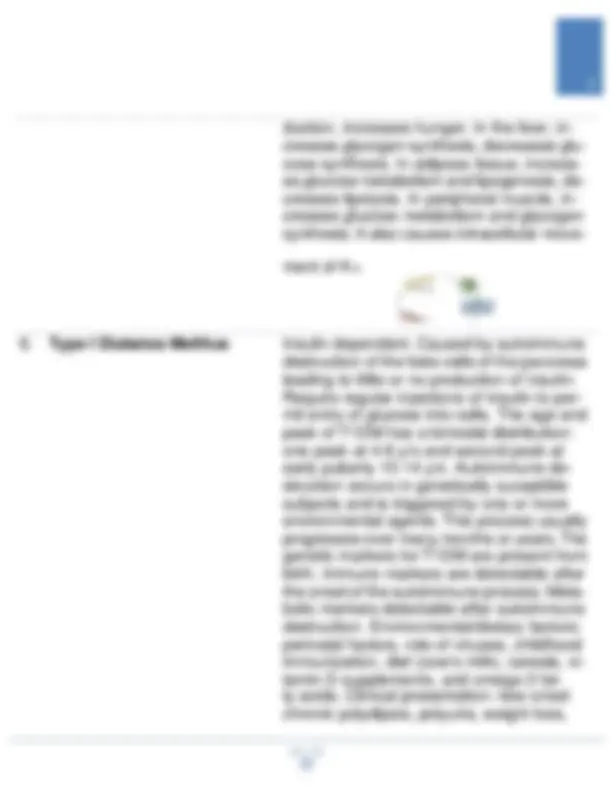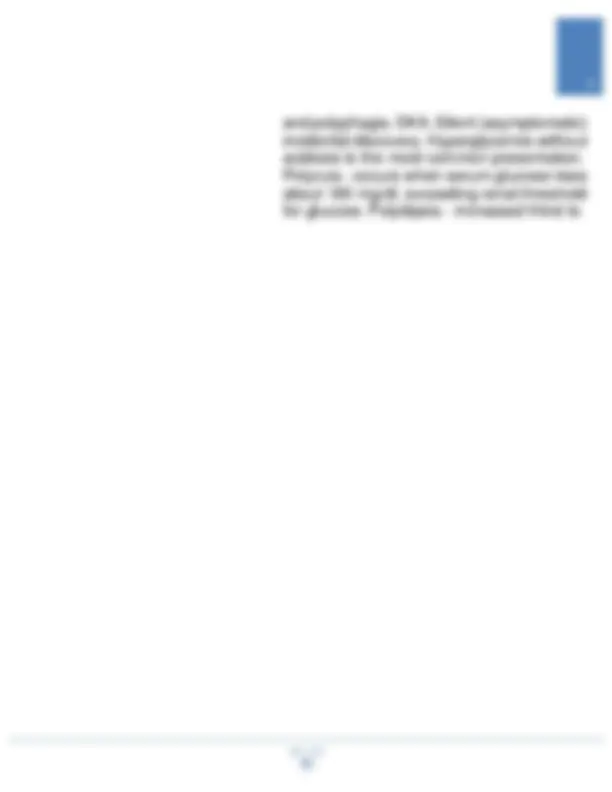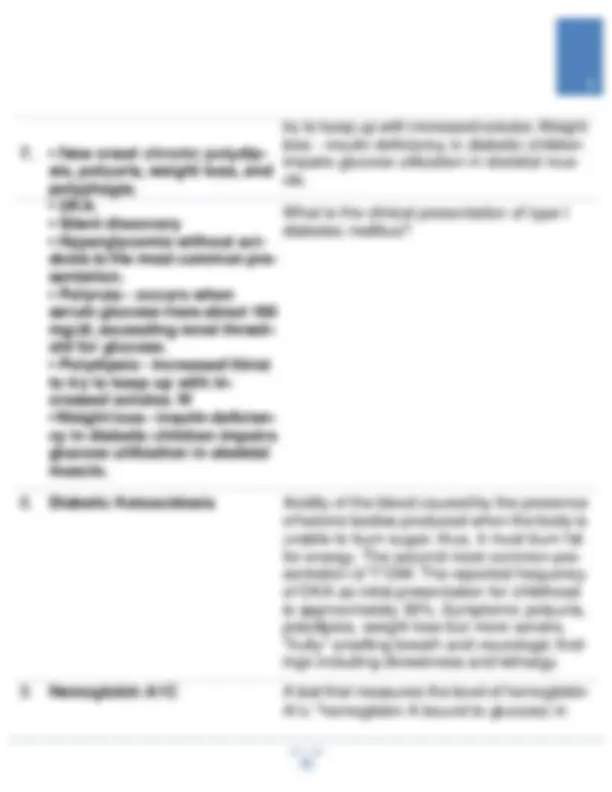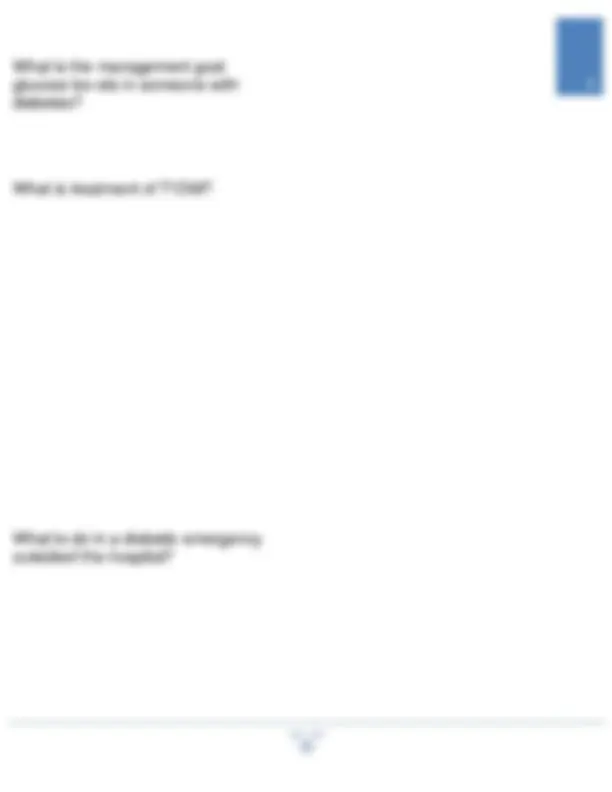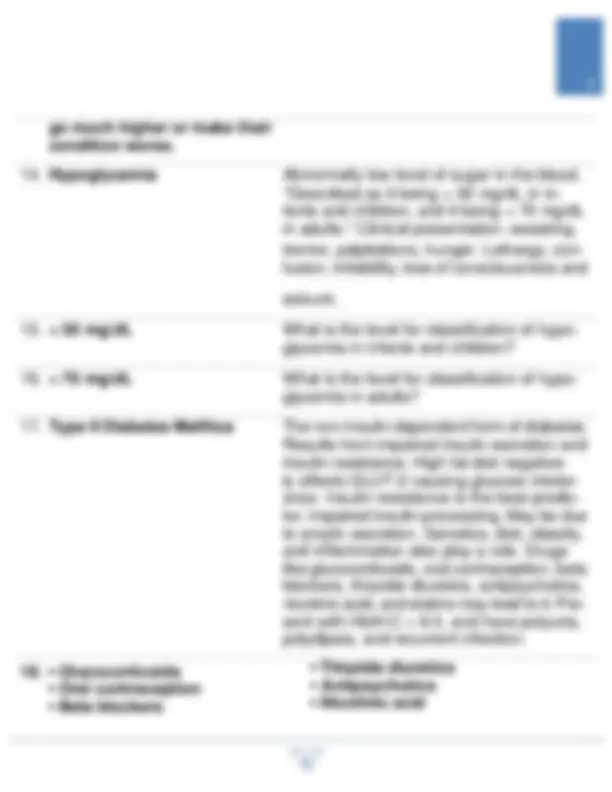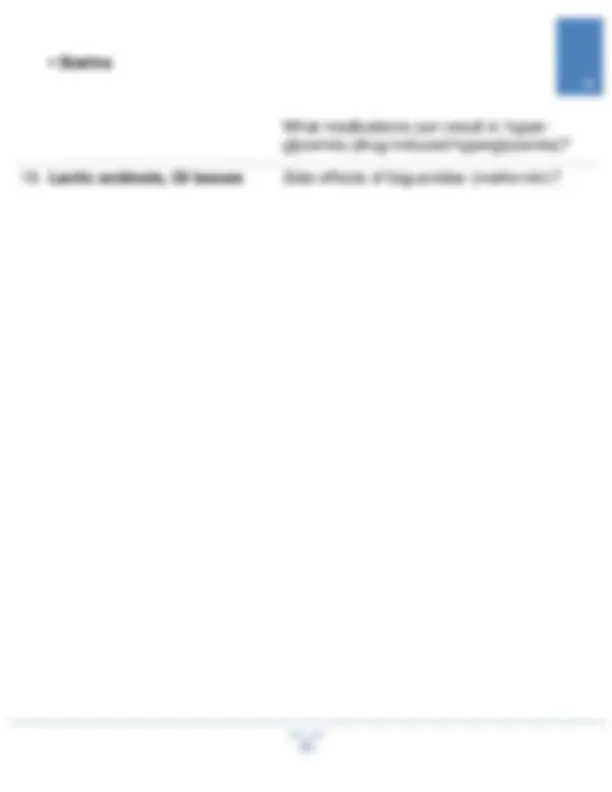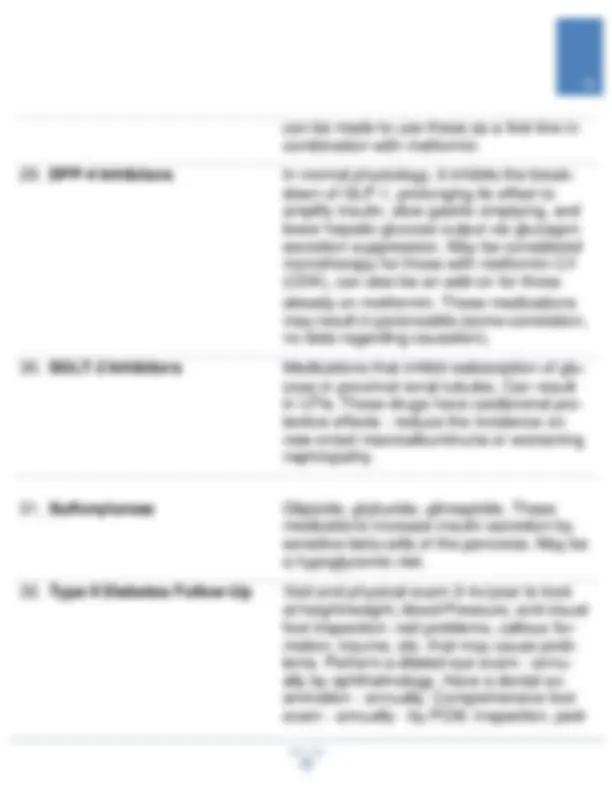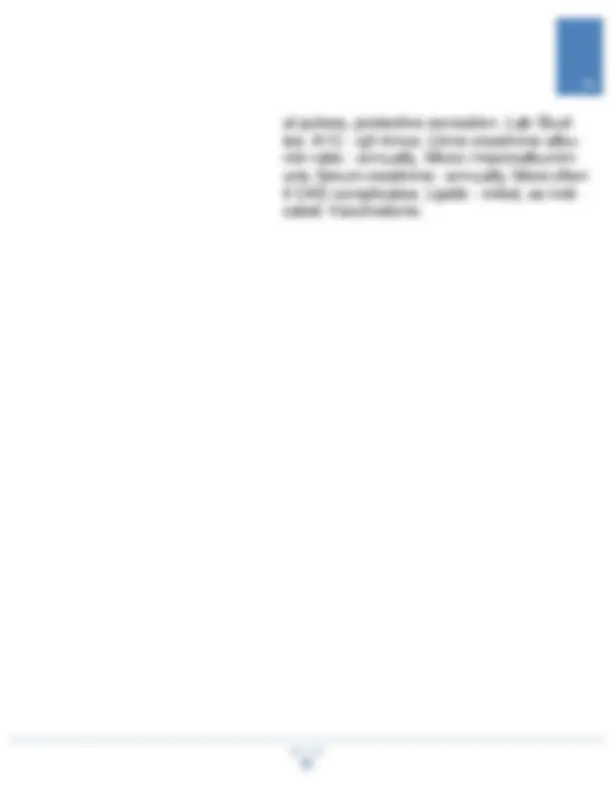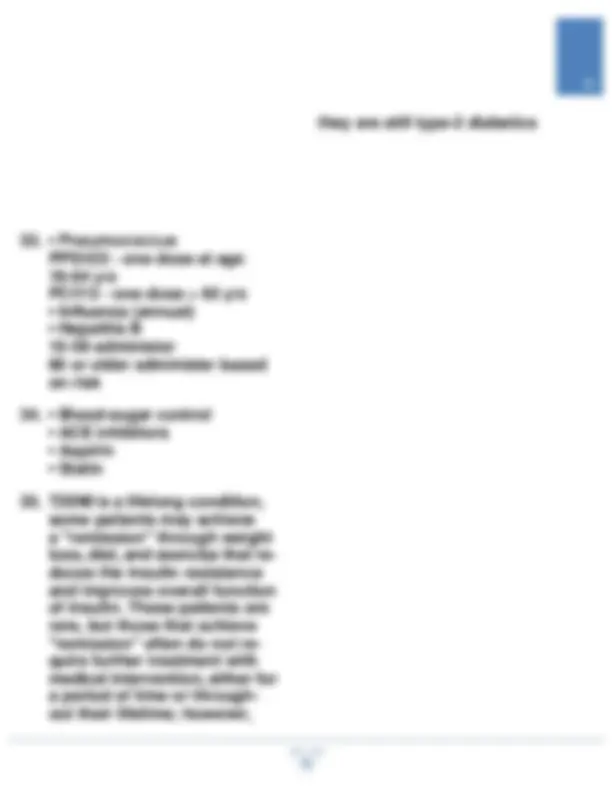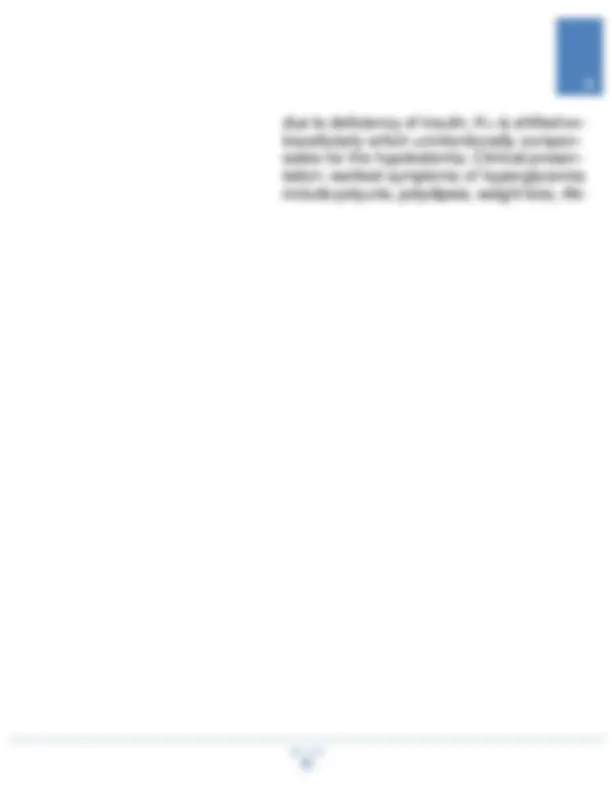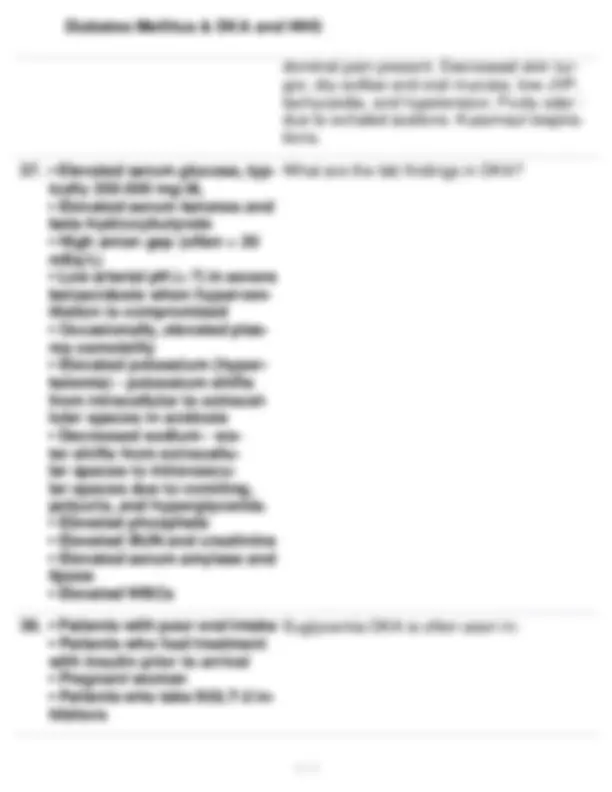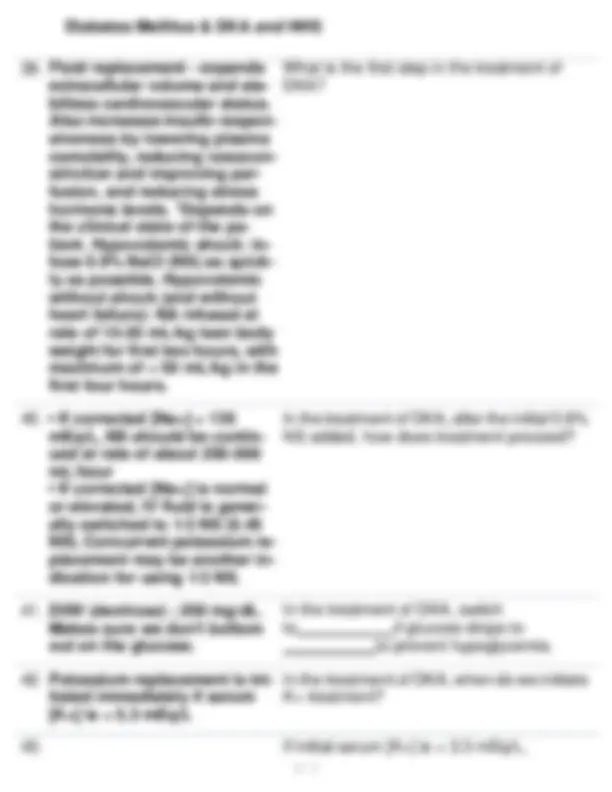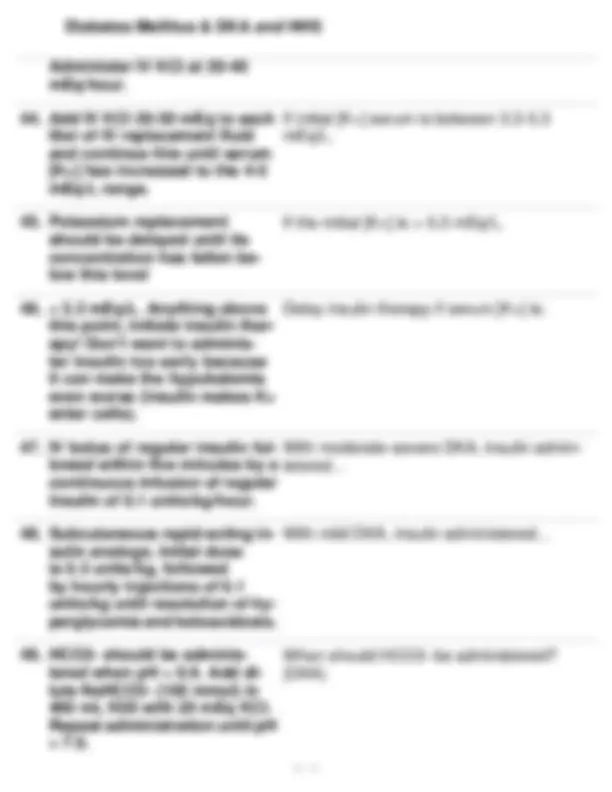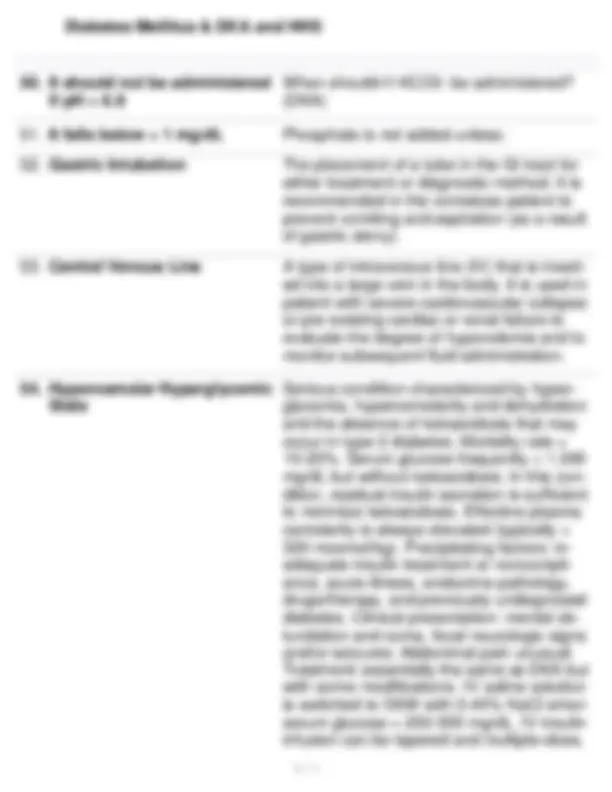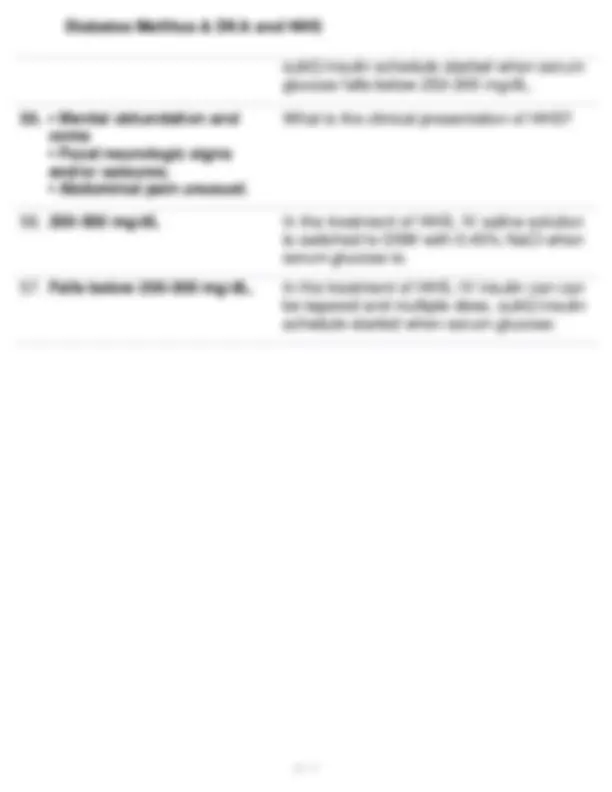Download Understanding Diabetes: Glycogen, Hormones, and Complications and more Exams Nursing in PDF only on Docsity!
1
- Glucose The primary source for energy into the cell.
- Glycogen Polysaccharide of stored glucose.
- Glucagon A protein hormone secreted by pancreatic endocrine cells that raises blood glucose levels; an antagonistic hormone to insulin. Promotes glycogenolysis in the liver.
- Incretins A group of hormones produced by the gas- trointestinal system that stimulate the re- lease of insulin from the pancreas and help preserve the beta cells.
- Insulin A protein hormone synthesized in the pan- creas that regulates blood sugar levels by facilitating the uptake of glucose into tis- sues. In the brain, decrease hepatic glu- cose production, decrease lipoprotein pro-
and polyphagia. DKA. Silent (asymptomatic) incidental discovery. Hyperglycemia without acidosis is the most common presentation. Polyruia - occurs when serum glucose rises about 180 mg/dl, exceeding renal threshold for glucose. Polydipsia - increased thirst to
7. • New onset chronic polydip- sia, polyuria, weight loss, and polyphagia. - DKA. - Silent discovery - Hyperglycemia without aci- dosis is the most common pre- sentation. - Polyruia - occurs when serum glucose rises about 180 mg/dl, exceeding renal thresh- old for glucose. - Polydipsia - increased thirst to try to keep up with in- creased solutes. W - Weight loss - insulin deficien- cy in diabetic children impairs glucose utilization in skeletal muscle. try to keep up with increased solutes. Weight loss - insulin deficiency in diabetic children impairs glucose utilization in skeletal mus- cle. What is the clinical presentation of type I diabetes mellitus?
- Diabetic Ketoacidosis Acidity of the blood caused by the presence of ketone bodies produced when the body is unable to burn sugar; thus, it must burn fat for energy. The second most common pre- sentation of T1DM. The reported frequency of DKA as inital presentation for childhood is approximately 30%. Symptoms: polyuria, polydipsia, weight loss but more severe, "fruity" smelling breath and neurologic find- ings including drowsiness and lethargy.
- Hemoglobin A1C A test that measures the level of hemoglobin A1c *hemoglobin A bound to glucose) in
average blood sugar concentrations for the preceding two to three months. Levels > 6. is now an accepted criterion for dx of DM in adults.
- Levels > 6.5% What is the hemoglobin A1C level to diag- nose someone with diabetes? 11. Levels < 7.5% Try to target blood-glucose level 90 to 130mg/dL before meals and 90 to 150 mg/dL at **bedtime and overnight.
- • Insulin therapy is the main-** stay of treatment of T1DM. - Rapid acting (lispro, aspart, glulisine) and/or short acting insulins (regular insulin) are typically administered as a premeal bolus (5 to 15 min- utes before the meal for the rapid-acting insulins and 20 to 30 minutes before meals for the short acting type) based on carbohydrate content of food and blood glucose level - Intermediate-acting NPH pro- vides some coverage for meals - Long-acting insulins (insulin glargine, insulin detimir) are **given once to twice a day
- Give glucose: If the patient is** in a diabetic coma from hyper- glycemia, you may just wake them up; conversely, if the pa-tient is in DKA or HHS, prob- ably not going to make BG
8 What is the management goal glucose lev-els in someone with diabetes? What is treatment of T1DM? What to do in a diabetic emergency outsideof the hospital?
10
- Statins What medications can result in hyper- glycemia (drug-induced hyperglycemia)?
- Lactic acidosis, GI issues Side effects of biguanides (metformin)?
- Hypoglycemia Side effects of sulfonylureas?
- Hypoglycemia Side effects of GLP- 1 agonists? 22. Pancreatitis (some correla- tion, no data regarding causa- tion) Side effects of DPP- 4 inhibitors?
- Increased risk of DKA Side effects of SGLT- 2 inhibitors?
- > 7.5 to 8% Pharmacologic therapy should be initiated for patients with A1C at or above target level %. 25. Metformin. Preferred therapy because of glycemic efficacy, absence of weight gain, and hypoglycemia. Beware of GI complaints and lactic acidosis (rare but potentially deadly) in **those with renal impairment
- • GLP- 1 agonist or SGLT- 2 in-** hibitor **- SGLT inhibitor
- Insulin or a GLP- 1 agonist** - If A1C > 9.5 with ketonuria - add insulin! What is the first line therapy for type II dia- betes mellitus? What is the second line therapy for type II diabetes? For patients with CVD or high CVD risk who cannot take metformin? For patients with heart failure or CKD? For patients with A1C 8.5 to 9.5 percent (or more) or fasting BG > 250, it is recommend- ed to add:
- GLP-1 Agonists In normal physiology, these medications stimulate GLP-1, which stimulates in- sulin suppression, slows gastric empty-
can be made to use these as a first-line in combination with metformin.
- DPP- 4 Inhibitors In normal physiology, it inhibits the break- down of GLP-1, prolonging its effect to amplify insulin, slow gastric emptying, and lower hepatic glucose output via glucagon secretion suppression. May be considered monotherapy for those with metformin C/I (CDK), can also be an add-on for those already on metformin. These medications may result in pancreatitis (some correlation, no data regarding causation).
- SGLT- 2 Inhibitors Medications that inhibit reabsorption of glu- cose in proximal renal tubules. Can result in UTIs. These drugs have cardiorenal pro- tective effects - reduce the incidence on new-onset macroalbuminuria or worsening nephropathy.
- Sulfonylureas Glipizide, glyburide, glimepiride. These medications increase insulin secretion by sensitive beta cells of the pancreas. May be a hypoglycemic risk.
- Type II Diabetes Follow-Up Visit and physical exam 2 - 4x/year to look at height/weight, blood Pressure, and visual foot inspection: nail problems, callous for- mation, trauma, etc. that may cause prob- lems. Perform a dilated eye exam - annu- ally by ophthalmology. Have a dental ex- amination - annually. Comprehensive foot exam - annually - by PCM. Inspection, ped-
al pulses, protective sensation. Lab Stud- ies: A1C - q3-4mos. Urine creatinine-albu- min ratio - annually. Micro-/macroalbumin- uria. Serum creatinine - annually. More often if CKD complicates. Lipids - initial, as indi- cated. Vaccinations:
16
- Pneumococcus: a) PPSV23: one dose at age 19- 64 y/o b) PCV13: one dose e65 y/o Prevnar-20: largely replacing both of theseregimens
- Influenza: annual
- Hepatitis B: a) 19 - 59 y/o: administer b) 60 and over: administer based on risk What vaccinations should be received if atype II diabetic? What medications should a type II diabeticbe on? What are the complications of type II dia-betes?
and require regular monitor- ing and follow-up. Complications:
**1. Diabetic retinopathy.
- Diabetic nephropathy - ACE-inhibitors (microalbumin- uria)
- Peripheral vascular disease
- Coronary artery disease a) ASA 81 b) Anti-hyperlipidemic (statin)
- Diabetic neuropathy - Gabapentin**
- Diabetic Ketoacidosis (DKA) A form of hyperglycemia in uncontrolled dia- betes in which keto acids accumulate when insulin is not available. Occurs due to in- sulin deficiency and/or resistance, glucagon excess, or increased secretion of cate- cholamines, cortisol, and growth hormone also contributes to increase in glucose and ketoacid production. Pathogenesis: insulin deficiency and resistance - > enhanced lipol- ysis from peripheral fat stores - > free fatty acids and glycerol are release. Fatty acids are taken up by hepatocytes - > activated coenzyme A (coA) to form acetyl-coA. When acetyl-coA is oversaturated, it is unable to enter Kreb's cycle, so it will enter ketgenic metabolic path to form acetoacetic acid (ke- tone) --> form beta-hydroxybutyric acid and acetone (makes breath smell fruity). Result in high anion gap metabolic acidosis. Hy- pokalemia not observed in DKA because
Diabetes Mellitus & DKA and HHS 19 / 14
37. • Elevated serum glucose, typ- ically 350 - 500 mg/dL - Elevated serum ketones and beta-hydroxybutyrate - High anion gap (often > 20 mEq/L) - Low arterial pH (< 7) in severe ketoacidosis when hyperven- tilation is compromised - Occasionally, elevated plas- ma osmolality - Elevated potassium (hyper- kalemia) - potassium shifts from intracellular to extracel- lular spaces in acidosis - Decreased sodium - wa- ter shifts from extracellu- lar spaces to intravascu- lar spaces due to vomiting, polyuria, and hyperglycemia. - Elevated phosphate - Elevated BUN and creatinine - Elevated serum amylase and lipase **- Elevated WBCs
- • Patients with poor oral intake** - Patients who had treatment with insulin prior to arrival - Pregnant women - Patients who take SGLT- 2 in- hibitors dominal pain present. Decreased skin tur- gor, dry axillae and oral mucosa, low JVP, tachycardia, and hypotension. Fruity odor - due to exhaled acetone. Kussmaul respira- tions. What are the lab findings in DKA? Euglycemia DKA is often seen in:
Diabetes Mellitus & DKA and HHS 20 / 14
- Fluid^ replacement^ -^ expands extracellular volume and sta- bilizes cardiovascular status. Also increases insulin respon- siveness by lowering plasma osmolality, reducing vasocon- striction and improving per- fusion, and reducing stress *hormone levels. Depends on the clinical state of the pa- tient. Hypovolemic shock: in- fuse 0.9% NaCl (NS) as quick- ly as possible. Hypovolemic without shock (and without heart failure): NA infused at rate of 15-20 mL/kg lean body weight for first two hours, with maximum of < 50 mL/kg in the first four hours. What is the first step in the treatment of DKA?
- • If corrected [Na+] < 135 mEq/L, NS should be contin- ued at rate of about 250- 500 mL/hour - If corrected [Na+] is normal or elevated, IV fluid is gener- ally switched to 1/2 NS (0. NS). Concurrent potassium re- placement may be another in- dication for using 1/2 NS. In the treatment of DKA, after the initial 0.9% NS added, how does treatment proceed?
- D5W (dextrose) ; 200 mg/dL. Makes sure we don't bottom out on the glucose. In the treatment of DKA, switch to if glucose drops to to prevent hypoglycemia.
- Potassium replacement is ini- tiated immediately if serum [K+] is < 5.3 mEq/L In the treatment of DKA, when do we initiate K+ treatment?
- If initial serum [K+] is < 3.3 mEq/L,

